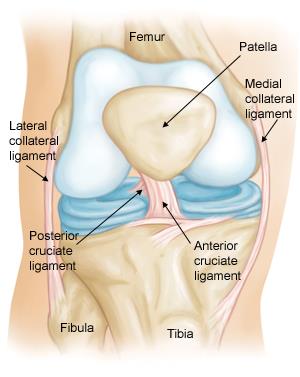Demystifying PCL Injuries: Causes, Symptoms, and Treatment Insights
PCL (posterior cruciate ligament) injuries cast a spotlight on knee health, impacting stability and mobility. Understanding their intricacies is vital for effective management. This comprehensive guide navigates the landscape of PCL injuries, shedding light on their role, causes, symptoms, and treatment strategies.
Understanding the PCL and Its Role:
The posterior cruciate ligament (PCL), a robust band of tissue in the knee, plays a pivotal role in maintaining joint integrity. Situated at the back of the knee, it counters backward movement of the tibia, ensuring smooth knee mechanics. Its harmony with other ligaments orchestrates a ballet of stability and flexibility within the joint.

Causes and Risk Factors of PCL Injuries:
PCL injuries often trace their origins to impactful forces on the knee. Collisions during sports, falls, and motor vehicle accidents are common catalysts. Hyperextension, where the knee bends beyond its natural range, can also strain or tear the PCL. Individuals engaged in high-impact activities or those with certain anatomical predispositions are particularly susceptible.
Recognizing Symptoms of PCL Injuries:
The subtlety of PCL injuries can be deceptive, as symptoms may not manifest immediately. Persistent knee pain, especially at the back, is a telltale sign. Swelling and tenderness, along with a sensation of instability or weakness in the knee, signal potential PCL involvement. Diagnosing these symptoms accurately is paramount for tailored treatment.
Diagnostic Methods for PCL Injuries:
Accurate diagnosis is the cornerstone of effective treatment. Medical professionals employ various methods, including physical examinations and imaging techniques like MRI scans. Physical assessments assess knee stability and pinpoint areas of tenderness, while advanced imaging provides detailed insights into the extent of PCL damage.
Grading PCL Injuries: Severity Matters:
PCL injuries encompass a spectrum of severity. A grading system categorizes them into three levels: Grade 1 (mild), Grade 2 (moderate), and Grade 3 (severe). Mild injuries may involve minor stretching, while severe cases result in complete ligament tears. Understanding the grade is crucial for determining the appropriate course of action.
Conservative Approaches to PCL Injury Treatment:
Mild to moderate PCL injuries often respond well to conservative measures. Rest, ice, compression, and elevation (RICE) are initial steps to manage pain and swelling. Physical therapy, focusing on strengthening and stabilizing the knee, aids recovery. Bracing might also be recommended to support the healing process.
Surgical Interventions for Severe PCL Injuries:
Severe PCL injuries, particularly Grade 3 tears, may require surgical intervention. Reconstruction or repair of the ligament might be performed. Surgeons use minimally invasive techniques to restore stability and function. Post-surgery, a structured rehabilitation program is essential for optimal recovery.
Post-Treatment Rehabilitation: Restoring Function:
Whether treated conservatively or surgically, rehabilitation is instrumental in restoring knee functionality. Physical therapists design customized plans involving exercises to rebuild strength, flexibility, and balance. Gradual progression is key to preventing reinjury and fostering a full recovery.
Long-Term Outlook and Prevention Strategies:
The road to recovery doesn’t end with treatment. Long-term outlook depends on factors such as injury severity and adherence to rehabilitation. Preventive measures include targeted exercises, proper warm-up routines, and using protective gear during sports. Vigilance and maintaining knee health contribute to avoiding future complications.
PCL Injury FAQs
What is a PCL injury, and where is the PCL located?
A PCL injury refers to damage to the posterior cruciate ligament, situated at the back of the knee joint. It plays a crucial role in stabilizing the knee.
What causes PCL injuries?
PCL injuries often result from impactful forces, such as sports collisions, falls, or hyperextension of the knee. High-impact activities and accidents are common culprits.
What are the symptoms of a PCL injury?
Symptoms of a PCL injury include persistent knee pain, swelling, tenderness at the back of the knee, and a feeling of instability or weakness in the joint.
How are PCL injuries diagnosed?
Medical professionals diagnose PCL injuries through physical examinations and imaging techniques like MRI scans. Physical assessments evaluate knee stability and tenderness, while imaging provides detailed insights.
What are the different grades of PCL injuries?
PCL injuries are graded based on severity: Grade 1 (mild), Grade 2 (moderate), and Grade 3 (severe). These grades reflect the extent of ligament stretching or tearing.
Can mild PCL injuries be treated without surgery?
Yes, mild to moderate PCL injuries can often be managed through conservative measures. Rest, ice, compression, elevation, and physical therapy are common approaches.
When is surgery required for PCL injuries?
Severe PCL injuries, especially Grade 3 tears, may require surgical intervention. Surgery is considered when conservative treatments aren’t sufficient for restoring knee stability.
What is the post-surgery rehabilitation process for PCL injuries?
After surgery, a structured rehabilitation program is essential. Physical therapists design personalized plans involving exercises to rebuild strength, flexibility, and balance.
Can PCL injuries lead to long-term complications?
Without proper treatment and rehabilitation, PCL injuries can lead to long-term complications, including chronic knee instability and reduced joint function.
How can PCL injuries be prevented?
Prevention strategies include proper warm-up routines, targeted exercises to strengthen the knee, and using protective gear during sports activities. Adhering to these measures can help minimize the risk of PCL injuries.
Conclusion:
PCL injuries cast a spotlight on the intricate mechanics of the knee. Understanding their role, recognizing symptoms, and pursuing timely treatment are pivotal for successful recovery. Armed with knowledge and guided by professionals, individuals can navigate the challenges of PCL injuries and stride confidently toward restored knee health.




